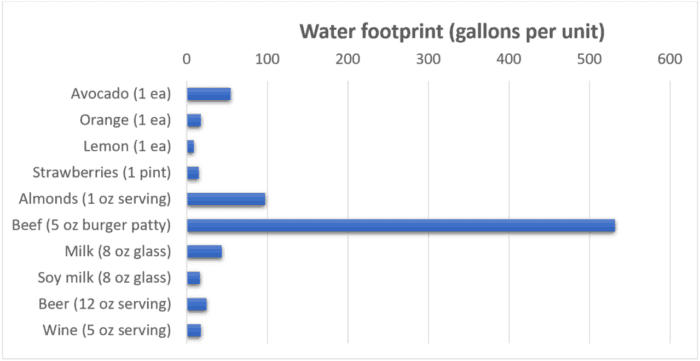Understanding Your Water Footprint
As we Californians embrace smarter, more efficient water use as a way of making our relationship with water more sustainable and more secure, we often focus on our residential water use as the primary place to conserve. Truth be told, residential water use – the water we use in our homes to take showers, wash dishes and clothes, water landscapes, and flush toilets – is only one part of the story when it comes to how much water we use each day. To get a better understanding of our real “water footprint,” we need to go a bit deeper. The fact is, everything that we consume in our daily lives takes water to produce. The water used to irrigate crops, to manufacture goods, and to produce energy all contribute to our indirect water use each day. This indirect water use actually far outweighs the water that comes through our taps, and it is crucial to understanding our personal water footprint and the water footprint of our cities and communities.

A look at the where the bulk of our water footprint lies
The average Californian’s per capita water footprint is roughly 1,500 gallons per day according to the Pacific Institute. By far the largest proportion of this goes towards the production of the foods we consume. The same study found that 93 percent of California’s statewide water footprint (approximately 64 million acre feet of water) is associated with agricultural production, with about half of that use in the meat and dairy sectors alone. An additional 3 percent is used in industrial production such as manufacturing. The remaining 4 percent represents direct water use in homes and businesses.
Data source: Water Footprint Network. It is important to note that these figures are based on national averages and actual water footprints can vary widely according to individual farming/production practices, but they should start to give you an idea of the magnitude of the indirect water use that contributes to our water footprint.
Finding out your personal water footprint
Similar to carbon footprint calculators, there are several resources available to examine your own water footprint. As a conscious conserver at home, I was a little astonished to learn the impact of some of the other choices I make when it comes to water use. Check out the quick and comprehensive Water Footprint Calculator and/or head over to the Water Footprint Network for a deep dive into their extensive database of water use statistics for products and services in the US and around the world.
What you can do to reduce your water footprint
As consumers, it’s up to us to make water smart choices when it comes to the products and services we use. Understanding the water footprint of the various purchases you make, and shifting a few of those choices a little can go a long way towards reducing your water footprint. Here are a few ideas to get you started:
Reduce or eliminate food waste. Wasted food means wasted water. According to the USDA, food waste in the US is estimated to be about 30-40 percent of the food supply. Therefore, with the average national water footprint of food at roughly 1,280 gallons per person per day, that’s up to 500 gallons of water per person tied up in wasted food each day!
Eat lower on the food chain. Most folks already know this one but it certainly bears repeating. A lot more water goes into the production of meat and dairy than into the production of vegetables and grains. With every single ounce of beef requiring over 100 gallons of water to produce, skipping meat in few extra meals per week – or simply reducing portion sizes – goes a long way towards reducing your water footprint.
Support businesses using smart water practices. Find companies making efforts to increase water efficiencies in their production lines or services, and reward them with your business!
Keep conserving at home. Yes, we’ve just finished telling you about all the water consumption that happens as a result of indirect water use, but here in San Diego County, 54 percent of water supplies go towards residential water use, with nearly half of that going to outdoor, ornamental landscaping. Conservation at home is still the easiest, most cost-effective way to ensure a sustainable long-term water supply for the San Diego region.
















